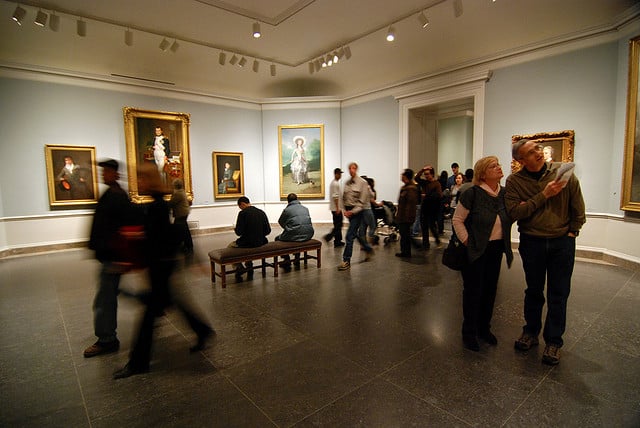
CultureCase summaries include research into interactions in museums
Photo: Kevin Harber (cc by nc-nd 2.0)
Out of obscurity
By bringing the findings of academic research into the wider cultural sector, CultureCase is providing the evidence that helps arts professionals make a stronger case for support. James Doeser looks back on the impact of its first year.
CultureCase provides short, accessible summaries of academic research that demonstrates the impacts of arts and culture, and highlights a range of insights that can be drawn from these. The sort of articles summarised in CultureCase might othewise sit for years in obscurity, behind paywalls and out of reach to all but a small handful of scholars. In the year since it was established, 110 articles have been summarised from academics working around the world. Papers published in the British Medical Journal or the Journal of Marketing Research are just as interesting to us as those in conventional arts or culture publications. They might look at the economic impact of festivals in Spain or the effect of singing on the immune system. What unites them is that they all have something credible and useful to say to advocates, practitioners and decision-makers in the cultural sector. We have also started to collaborate with The Digest (from the University of Chicago) and have trained a cohort of early career researchers at King’s College London as expert research communicators.
It would be interesting to know how many applicants cited research in their proposals, or whether ACE itself used high-quality research on ‘what works’ to assess those proposals
The shape of CultureCase – its strengths and weaknesses – broadly reflects that of the wider academic literature. There is a glut of material on the educational and health benefits of actively participating in the arts. There is also plenty of insight into how to understand audiences (think of it as an academic-grade CultureHive). According to our web analytics, 10,000 visits have been made by around 7,000 users, two-thirds of whom are based in the UK. The most popular articles refer to the health, wellbeing and educational benefits of arts engagement for children and the elderly. Visitors to the site are finally getting easy access to those credible and robust studies that help them make the case for support.
We know that people like to draw on evidence of the positive impacts of arts and culture, but we also acknowledge that we have more work to do to embed the habitual use of evidence in planning, programming and decision-making. We also know there is an unfulfilled demand for more research on the environmental impacts of arts and culture, and on partnership working. The site will continue to expand to fill these gaps and we are always keen to be tipped off about any forthcoming or published papers that people think might be worth summarising.
A lot has happened in the arts and cultural world during our first year. The site was launched a month after Arts Council England’s (ACE) deadline for applications to the 2015-18 national portfolio. It would be interesting to know how many applicants cited research in their proposals, or whether ACE itself used high-quality research on ‘what works’ to assess those proposals. Since our launch, there has been the establishment of the Creative Industries Federation, and ongoing work funded through the Digital R&D Fund run by Nesta, ACE and the AHRC Cultural Value project. Elsewhere in the research landscape there has been the recent report from the Warwick Commission and an open call for applications to an unprecedented £700k ACE Research Grants Fund.
The enormous variety and scale of the work funded through the AHRC and Nesta programmes should ensure that an avalanche of relevant, applicable research will be available during the next year. Between them these organisations have funded more than 100 individual pieces of research, many of which look at questions of impact, consumer behaviour and how to attract funding. We have been living in an age of plenty in this regard, and I would expect every peer-reviewed article resulting from these studies to make its way on to CultureCase. However, there will inevitably be a time lag. The most relevant academic journals for readers of ArtsProfessional (such as Cultural Trends and the International Journal of Cultural Policy) tend to have publication cycles that mean research can take years to move from field work to publication. It is partly a consequence of the quality assurance process associated with peer review. In addition, not all the papers published in journals report empirical research. Some are more theoretical in nature, suggesting that people should think in this way or that way about a particular issue, without offering up new data on which to base these shifts in perspectives.
This hints that the academic world is not necessarily responding to the immediate research needs of advocates and practitioners in the cultural sector. Maybe they should not – these are different worlds with different priorities. But given that the arts is a sector having to deal with constrained resources and successive funding rounds that have cut sector development to protect ‘front-line arts’ provision, it would make sense for all concerned for higher education to work in closer collaboration with the cultural sector. Our longer-term ambitions are that it is a focal point for research commissioners, a simple platform for them to identify gaps in our knowledge and the research literature.
With a new government on the way (and inevitably another spending review to follow), are the arts sector and policy-makers really prepared for what the RSA calls “a more grown up and rigorous conversation about arts and cultural policy”? Such a conversation must be informed (if not led) by high-quality research – exactly the sort that can be easily found on CultureCase.
James Doeser is a Research Associate for Culture at King's College London and Editor of CultureCase.
www.culturecase.org
[email protected]
Join the Discussion
You must be logged in to post a comment.